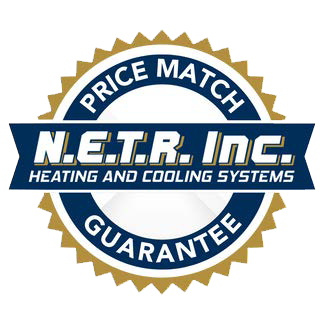The humidity levels in your home can have a significant impact on your health and comfort. Ideally, your home’s humidity shouldn’t be either too low or too high. Here’s what you should know about humidity and air quality and how N.E.T.R., Inc. can help you obtain heating and cooling comfort along with excellent indoor air quality.
How Humidity Impacts Air Quality
Humidity is a measurement of the amount of water vapor suspended in the air. Humid air feels “wetter” and warmer than air with less humidity, and a measurement of 100% humidity means that the air is holding as much water vapor as it can at its current temperature. If the air in your home is too dry or too humid, the quality of your air will naturally drop.
Effects of High Humidity
Air that is too humid can be uncomfortable. It can feel hot and sticky, and even good air flow often fails to make humid air tolerable for any length of time.
High humidity can also impact how many toxic chemicals are suspended in the air; these chemicals attach to the water molecules in the air, meaning that the more moisture there is in the air, the more chemicals there are too. It can also create a dustier environment, potentially triggering allergies along with other upper respiratory symptoms.
Effects of Low Humidity
Air that isn’t humid enough can also be uncomfortable. It can feel dry and irritating, causing itchy eyes, a runny nose, a sore throat, and a mild dry cough. It can also result in dry skin, chapped lips, dehydration, and an increase in respiratory illnesses.
Air without enough humidity also tends to promote the spread of viral and bacterial particles. This is generally why cold and flu season is in the winter, when the air indoors and out is much drier than in the spring and summer. It’s also why surgical suites typically have multiple humidifiers in a controlled climate environment.
How Humid Should My Home Be?
The U.S. Environmental Protection Agency (EPA) reports that to for ideal comfort and health, indoor air should fall between 30% and 50%, without exceeding 60% or dropping below 20%. You can measure the humidity in your home with a simple gauge that can be purchased at most hardware, home supply, and pet stores that sell reptile enclosures and accessories.
How Massachusetts’ Winters Kill Moisture in Your Home’s Air
Air is only able to hold up to a certain amount of water vapor depending on its temperature. Colder air naturally holds less water than warmer air, making it inherently drier on its own. Combine this with dry, hot air pumped into your home by your heating system during Massachusetts’ cold winters and you may not see your indoor humidity above 15% to 20% without some help.
How to Increase the Humidity in Your Home
Usually, New England families need to supplement their home’s humidity in the winter to keep it around 50%. Winters in the Northeast are cold and harsh, and there’s rarely enough moisture outdoors to keep the air in your home comfortable, especially when you have your heater running.
You can improve the overall moisture levels in your home’s air purchasing a simple piece of equipment called a humidifier. These are available at superstores, home supply stores, and some hardware stores. A humidifier turns water into water vapor and releases it into the air, quickly increasing the relative humidity. Depending on how large your home is, you may need more than one humidifier to keep your home above 30% humidity.
Types of Humidifiers
There are several different types of humidifiers you can choose from and which is right for your home depends on your unique needs.
1. Steam Vaporizers
A steam vaporizer uses a heating element to heat water and convert it to steam, which is cooled and then released into the air. Steam vaporizers can also be used to treat upper respiratory symptoms like a stuffy nose and cough. A steam vaporizer can result in scalding if too close to the body, so it should be used carefully in homes with children or individuals who are at risk of injury.
2. Cool Mist Humidifiers
Cool mist humidifiers work differently than steam vaporizers to achieve the same goal. This type of humidifier uses a filter that acts as a wick to soak up water, which air is pushed through by a fan to pump water vapor into the surrounding air. Cool mist humidifiers are often better to use when you need consistent humidity support, since they don’t pose a risk of burns and tends to use less energy than steam vaporizers.
Either type of device can be used to increase the humidity in your home. Start with one humidifier in a central location and use a hygrometer, or humidity gauge, to ensure that you don’t tip the scale over 60% humidity. Add a second or third humidifier if your hygrometer shows that you still aren’t able to reach your desired level of humidity after a few days.
How N.E.T.R., Inc. Can Help You Improve Your Home’s Air Quality
At N.E.T.R., Inc., we’re passionate about home comfort and that includes the quality of the air in your house. We can help you discover heating, cooling, and air quality solutions that are custom designed for your family’s unique needs and comfort goals.
We’ve been serving Boston and surrounding areas in New England since 1989, and our expertly trained HVAC technicians can assist you in getting the most heating and cooling for your money. Contact us today to learn more about how to improve your air quality and how we can help by calling 781.933.NETR (6387).

